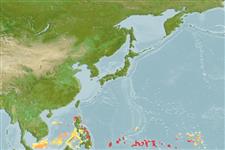>
Acanthuriformes (Surgeonfishes) >
Chaetodontidae (Butterflyfishes)
Etymology: Chaetodon: Greek, chaite = hair + Greek, odous = teeth (Ref. 45335).
Eponymy: Dr Warren E Burgess is an American ichthyologist and research scientist who co-wrote: Dr Burgess’s Atlas of Marine Aquarium Fishes (1988) and the Colored Atlas of Miniature Catfish (1992). [...] (Ref. 128868), visit book page.
Environment: milieu / climate zone / depth range / distribution range
Ecologia
marinhas associadas(os) a recifes; intervalo de profundidade 20 - 130 m (Ref. 90102). Tropical; 19°N - 6°N
Western Pacific: Philippines and northeastern Borneo to Flores and Pohnpei. Recently reported from Tonga (Ref. 53797).
Tamanho / Peso / Idade
Maturity: Lm ? range ? - ? cm
Max length : 14.0 cm TL macho/indeterminado; (Ref. 9710)
Espinhos dorsais (total) : 13; Raios dorsais (total) : 18 - 19; Espinhos anais: 3; Raios anais : 15 - 16. Body is white with broad diagonal black stripes across the body, the first from the origin of the first dorsal spine to the soft portion of the anal fin, the second from just anterior of the dorsal fin extending postero-ventrally ending at about the level of the pectoral fin, and the third running vertically across the eye from the forehead (Ref. 4855). Snout length 2.8-3.0 in HL. Body depth 1.6-1.7 in SL (Ref. 90102).
Occur in drop-offs where gorgonians and black corals are abundant. Usually in depths over 40 m, but in some localities much shallower (Ref. 48636); usually in depths less than 40 m in East Indian region, solitarily or in pairs (Ref 90102). Reported to have been collected from a depth of 380 feet (= 115.8 m) in Palau (J.C. Delbeek, CAS, pers.comm. 10/2017) . Oviparous (Ref. 205). Form pairs during breeding (Ref. 205). They do well in the aquarium and are exported from the Philippines (Ref. 37816). Maximum depth reported taken from Ref. 128797.
Ciclo de vida ou comportamento de acasalamento
Maturidade | Reprodução | Desova | Ovos | Fecundidade | Larvas
Form pairs during breeding (Ref. 205).
Myers, R.F., 1991. Micronesian reef fishes. Second Ed. Coral Graphics, Barrigada, Guam. 298 p. (Ref. 1602)
Status na Lista Vermelha da UICN (Ref. 130435: Version 2024-1)
Ameaça para os humanos
Harmless
Uso pelos humanos
Pescarias: espécies comerciais; Aquário: Espécies comerciais
Ferramentas
Relatórios especiais
Baixar XML
Fontes da internet
Estimates based on models
Preferred temperature (Ref.
123201): 25.7 - 28.7, mean 28 °C (based on 13 cells).
Índice de diversidade filogenética (Ref.
82804): PD
50 = 0.5000 [Uniqueness, from 0.5 = low to 2.0 = high].
Bayesian length-weight: a=0.02291 (0.01133 - 0.04632), b=3.00 (2.83 - 3.17), in cm total length, based on LWR estimates for this Genus-body shape (Ref.
93245).
Nível Trófico (Ref.
69278): 3.5 ±0.37 se; based on food items.
Resiliência (Ref.
120179): Elevada, tempo mínimo de duplicação da população menor que 15 meses (Preliminary K or Fecundity.).
Fishing Vulnerability (Ref.
59153): Low vulnerability (10 of 100).
